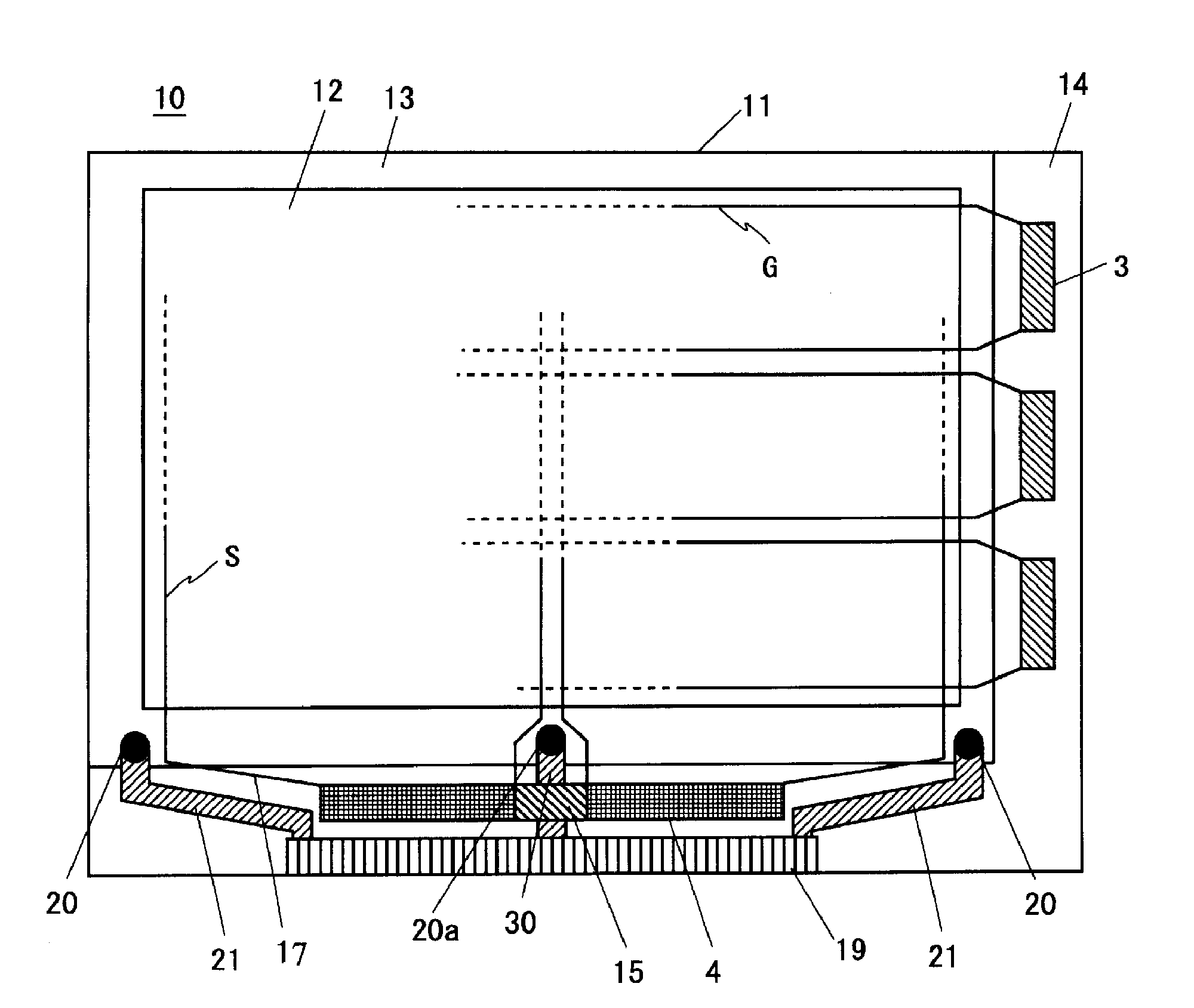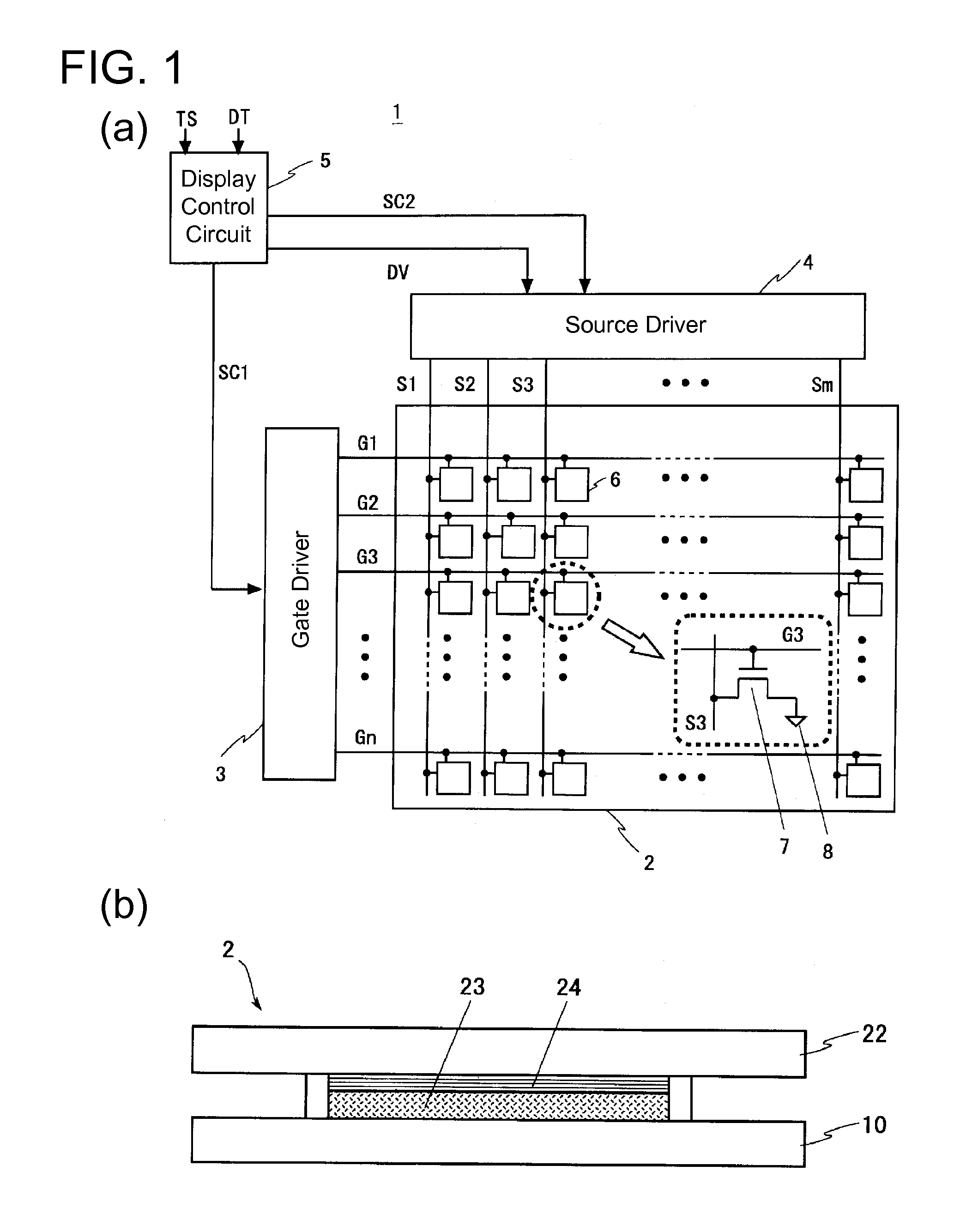Display device and method of manufacturing same
a liquid crystal display and display device technology, applied in optics, instruments, electrical appliances, etc., can solve the problems of increasing the susceptibility of the image displayed in the liquid crystal display device to display unevenness, increasing the likelihood of image shadowing, and increasing the load on the common signal line. , to achieve the effect of preventing a decrease in display quality in the display device, shortening the length of the common signal line, and reducing the risk of image shadowing
- Summary
- Abstract
- Description
- Claims
- Application Information
AI Technical Summary
Benefits of technology
Problems solved by technology
Method used
Image
Examples
embodiment 1
1. Embodiment 1
[0122]
[0123]FIG. 1(a) is a block diagram that shows a configuration of an active matrix liquid crystal display device 1 according to Embodiment 1 of the present invention, and FIG. 1(b) is a cross-sectional view of a liquid crystal panel 2 included in the liquid crystal display device 1 shown in FIG. 1(a). As shown in FIG. 1(a), the liquid crystal display device 1 includes the liquid crystal panel 2, a gate driver 3, a source driver 4, and a display control circuit 5. The gate driver 3 and the source driver 4 are sometimes collectively referred to as “first driver circuits.” If a plurality of either the gate drivers 3 or the source drivers 4 are included in embodiments or application examples below, then these are sometimes collectively referred to as “second driver circuits.”
[0124]As shown in FIG. 1(b), the liquid crystal panel 2 includes a TFT substrate 10 (also referred to as a “first substrate”), an opposite substrate 22 (also referred to as a “second substrate”),...
embodiment 2
2. Embodiment 2
[0186]FIG. 20 is a drawing that shows a configuration of a TFT substrate 60 included in a liquid crystal display device 1 according to Embodiment 2 of the present invention. FIG. 21 is a magnified view of the vicinity of a source driver mounting region 25 of the TFT substrate 60 shown in FIG. 20. The configuration of the liquid crystal display device 1 of the present embodiment and the method of forming the source driver mounting region 25 are both the same as those of Embodiment 1, and therefore, descriptions thereof are omitted. Also, components that are the same as the components of the TFT substrate of Embodiment 1, or corresponding components thereof, are assigned the same reference characters with descriptions thereof omitted.
[0187]As shown in FIG. 2, in the TFT substrate 10 of Embodiment 1, the common signal was applied to the common signal lines 21 and 30 from an external source through the FPC substrate, but in the TFT substrate 60 of the present embodiment, ...
embodiment 3
3. Embodiment 3
[0190]FIG. 22 is a drawing that shows a configuration of a TFT substrate 70 included in a liquid crystal display device 1 according to Embodiment 3 of the present invention. FIG. 23 is a magnified view of the vicinity of a driver mounting region 25 of the TFT substrate 70 shown in FIG. 22. The configuration of the liquid crystal display device 1 of the present embodiment and the method of forming the driver mounting region 25 are both the same as those of Embodiment 1, and therefore, descriptions thereof are omitted. Also, components that are the same as the components of the TFT substrate 10 of Embodiment 1, or corresponding components thereof, are assigned the same reference characters with descriptions thereof omitted.
[0191]As shown in FIG. 22, in an element region 14 of the TFT substrate, a one-chip driver 9 is mounted, the one-chip driver 9 being constituted of a source signal output part 9a, and gate signal output parts 9b that sandwich the source signal output ...
PUM
| Property | Measurement | Unit |
|---|---|---|
| thickness | aaaaa | aaaaa |
| thickness | aaaaa | aaaaa |
| thickness | aaaaa | aaaaa |
Abstract
Description
Claims
Application Information
 Login to View More
Login to View More - R&D
- Intellectual Property
- Life Sciences
- Materials
- Tech Scout
- Unparalleled Data Quality
- Higher Quality Content
- 60% Fewer Hallucinations
Browse by: Latest US Patents, China's latest patents, Technical Efficacy Thesaurus, Application Domain, Technology Topic, Popular Technical Reports.
© 2025 PatSnap. All rights reserved.Legal|Privacy policy|Modern Slavery Act Transparency Statement|Sitemap|About US| Contact US: help@patsnap.com



